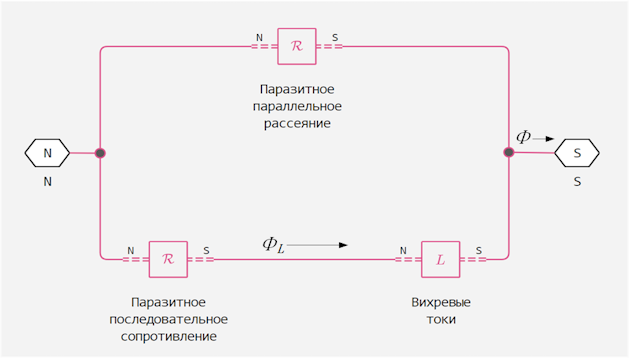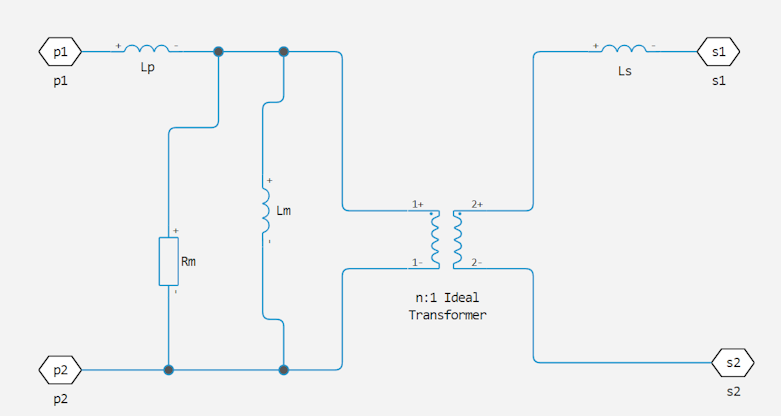Eddy Current
Eddy currents.
blockType: AcausalElectricPowerSystems.Passive.EddyCurrent
|
Path in the library: |
Description
The Eddy Current block simulates the effects of eddy currents by creating a magnetomotive force (MDF) to counteract the change in magnetic flux. The block also models parasitic effects using series resistance and parallel dissipation resistance, and thermal effects using the optional H thermal port.
Eddy currents in magnetic cores are induced by time-varying magnetic fields. The changing flux induces EMF in the material, causing closed loop currents. Such currents are usually undesirable and cause heating of the magnetic core.
This block is used to add eddy current losses in the magnetic domain to a custom transformer or other magnetic component.
Eddy current is sometimes referred to as magnetic inductance because it is the magnetic analogue of an electrical inductance coil.
Equations
Equivalent magnetic circuit of a unit including an eddy current circuit (bottom) and a parallel scattering circuit (top):

In the schematic:
-
- Total flux at the terminals. This flux is made up of the eddy current flux and the parallel dissipation flux.
-
- flux through the eddy current loop.
The block calculates the terminal MDS, , and the flux, , as:
Where:
-
- is the conductivity of the eddy current loop.
-
- parasitic series resistance of eddy current loop.
-
- parallel dissipation.
Since the parasitic series resistance and parallel resistance are lossless, the total power dissipation in the block is:
Relationship between the electrical and magnetic models of the transformer
In the electrical domain, eddy current losses are modelled using the parallel resistance of the primary winding. Equivalent circuit of a non-ideal two-winding transformer:

In the schematic:
-
and are the intrinsic inductance of the primary and secondary windings, respectively.
-
- mutual inductance of the two windings.
-
- mutual resistance of the two windings due to eddy current losses.
This two winding transformer can be similarly represented in the magnetic domain. Equivalent circuit:

In the schematic:
-
and are the resistances associated with the primary and secondary windings, respectively.
-
- resistance associated with the magnetic coupling of the two windings.
-
- the ratio of turns between the two windings.
Electric and magnetic circuits are equivalent if:
These relations can be used to calculate the equivalent properties of a two-winding transformer for one region based on the other.
Ports
Non-directional
N - north terminal
`magnetism
Magnetic port corresponding to the north terminal of the unit.
S is the south terminal
magnetism
Magnetic port corresponding to the south terminal of the unit.
H - heat port
heat
Heat port
Dependencies
To use this port, select the Enable thermal port checkbox.
Parameters
Conductance of eddy current loop - conductance of eddy current loop
1 1/ohm (by default) | positive number
Eddy current loop conductance, . This component is the analogue of magnetic inductance in the electrical domain.
Parasitic series reluctance - series resistance
1e-3 1/GN (by default) | non-negative number.
Parasitic resistance eddy current loop.
Parasitic parallel permeance - parallel scattering permeance
1e-6 Gn (by default) | non-negative number
Parasitic permeability of the parallel scattering loop. Some circuit topologies should be set to a small value of this parameter to facilitate modelling convergence.
Enable thermal port - visibility of thermal port
enabled (by default) | enabled.
Select this checkbox to enable the heat port H
Thermal mass - thermal mass
0.1 J/K (by default) | positive number
Thermal mass of the block. This parameter controls the absorption and storage of thermal energy in the block.
Dependencies
To use this parameter, select the Show thermal port checkbox.
